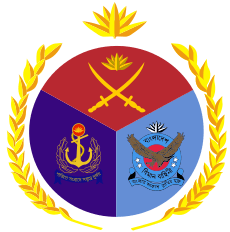Bangladesh Air Force
The Bangladesh Air Force (Bengali: বাংলাদেশ বিমান বাহিনী, Bangladesh Biman Bahini, reporting name: BAF), is the aerial warfare branch of the Bangladesh Armed Forces, primarily tasked with the air defence of Bangladesh's sovereign territory, and providing air support to the Bangladesh Army and Bangladesh Navy. Additionally, the service has a territorial role of providing tactical and strategic air transport and logistics capability for the country.
| Bangladesh Air Force | |
|---|---|
| বাংলাদেশ বিমান বাহিনী | |
 The Crest of the Bangladesh Air Force | |
| Founded | 1971 |
| Country | Bangladesh |
| Type | Air force |
| Role | Aerial warfare |
| Size | 14,000 active personnel[1] 159 aircraft[2] |
| Part of | Bangladesh Armed Forces |
| Air Headquarters | Dhaka Cantonment |
| Patron | The President of Bangladesh |
| Motto(s) | বাংলার আকাশ রাখিব মুক্ত Transliteration:Banglar Aakash Rakhibo Mukto (Free shall we keep the sky of Bangladesh)[3] |
| Colors | Light Sky, Deep sky |
| Mascot(s) | Flying Eagle |
| Anniversaries | 28 September (Air Force Day), Armed Forces Day (21 November) |
| Engagements | Bangladesh Liberation War Gulf War Chittagong Hill Tracts operation United Nations peacekeeping missions |
| Website | www.baf.mil.bd |
| Commanders | |
| Commander-in-chief | President Abdul Hamid |
| Chief of Air Staff | Air Chief Marshal Masihuzzaman Serniabat, BBP, OSP, ndu, psc |
| Insignia | |
| Roundel |  |
| Fin flash | |
| Flag |  |
| Aircraft flown | |
| Attack | Yak-130, Mil Mi-17 |
| Fighter | MiG-29SE, F-7 |
| Helicopter | Bell 212, Mi-17, AW 139 |
| Trainer | PT-6, AW 119, Bell 206, L-39, FT-7, K-8, YAK 130, L-410 |
| Transport | C-130B, An-32, C130J, L-410 |
Since its establishment on 28 September 1971, the Air Force has been involved in various combat and humanitarian operations, from the Bangladesh Liberation War in which it was born, to supporting international efforts including the Coalition of the Gulf War and United Nations peacekeeping missions.
History
Foundation

The Bangladesh Air Force was officially formed on 28 September 1971 consisting of the revolting Bengali officers and airmen of the Pakistan Air Force at Dimapur of Nagaland, India[4] and it was launched formally by flying three repaired vintage aircraft on 8 October 1971.[5] BAF's initial personnel were Bengali members of the Pakistan Air Force who were stationed in East Pakistan at the outbreak of the war and who deserted to the Bangladeshi side.[5] At that time, the embryo of Bangladesh Air Force BAF was formed with less than a hundred officers and a handful of airmen and warrant officers. A significant number of BAF personnel participated in the Bangladesh War of Independence. During the independence war, initially, officers of the BAF attached to the then Bangladesh Government were Chief Representative to Chakulia Guerrilla Training Camp Squadron Leader M. Hamidullah Khan, Group Captain A. K. Khandekar, DCOS Army(Liaison) later Sub-Sector Commander and as Commander - Sector 11, Flight Lieutenant Liaqat as Battalion Adjutant, Flying Officer Rouf, Flying Officer Ashraf and Flight Sergeant Shafiqullah as company commanders. Squadron Leader Sadruddin Hossain, Squadron Leader Wahidur Rahim, Squadron Leader Nurul Qader, Squadron Leader Shamsur Rahman and Air Commodore Ataur Rahman as sub sector company commanders. Squadron Leader Khademul Bashar participated in the war as Commander-Sector 6.
Indian civilian authorities and the IAF donated 1 DC-3 Dakota (gifted by the Maharaja of Jodhpor), 1 Twin Otter plane, and 1 Alouette III helicopter for the newborn Bangladesh Air Force,[6] which was to take advantage of the lack of night-fighting capability of the PAF to launch hit-and-run attacks on sensitive targets inside Bangladesh from the air.[7] The Bengali rank and file fixed up the World War II vintage runway at Dimapur, then began rigging the aircraft for combat duty. The Dakota was modified to carry 500 pound bombs, but for technical reasons it was only used to ferry Bangladesh government personnel. The Alouette III helicopter was rigged to fire 14 rockets from pylons attached to its side and had .303 Browning machine guns installed, in addition to having 1-inch (25 mm) steel plate welded to its floor for extra protection. The Twin Otter boasted 7 rockets under each of its wings and could deliver ten 25 pound bombs, which were rolled out of the aircraft by hand through a makeshift door. This tiny force was dubbed Kilo Flight, the first fighting formation of the nascent Bangladesh Air force. Squadron Leader Sultan Mahmud was appointed as the commander of the 'Kilo Flight'.[8][9]
.png)
Bangladesh Air Force first went in action on 3 December 1971 and attacked the Chattogram-based Oil tank depot and oil tank depot was totally destroyed by that air attack. The Air attack was conducted by Capt. Akram Ahmed.[10] The second Bangladesh Air Force attack was on 6 December 1971 at Moulovi Bazar Pakistani Army barracks under the command of Squadron Leader Sultan Mahmud, where Captain Shahabuddin Ahmed was co-pilot.[10]
After the cease fire and surrender of Pakistan, all personnel reported to Bangladesh Forces commander-in-chief, Col. M. A. G. Osmani. On 7 April 1972, the post of the chief of air staff went into effect by order of the President of Bangladesh. The combined command of Bangladesh Forces had been abolished with effect from 7 April 1972 and replaced by three separate commands for the three services with acting chiefs of staff. The Bangladesh air force gradually began to reoccupy the reform all the airbase structures throughout the country, HQ administrative buildings, fuel and weapons depots.
After independence
.jpg)
After independence, the BAF received a significant donation from the former USSR. Among the aircraft delivered were ten single-seat Mikoyan-Gurevich MiG-21MFs and two twin-seat Mikoyan-Gurevich MiG-21UMs. Later China also supplied some equipment.[6]
Apart from the aircraft of Kilo Flight which were donated to India, most Pakistan Air Force aircraft grounded in Dhaka due to runway cratering by the Indian Air Force during the liberation war, were sabotaged before surrender. Many of these were also returned to service by Bangladeshi ground technicians. The Pakistan Air Force prior to 1971 had many Bengali pilots, air traffic controllers, technicians and administrative officers. Many of them distinguished themselves during the Bangladesh Liberation War, they provided the nascent Bangladesh Air Force with a good number of trained personnel. It had grown with the repatriation of Air Force personal from Pakistan in 1973 after the Simla Agreement.[5] In 1977 some personnel of Bangladesh Air Force staged a mutiny.[11]
Defence co-operation improved with Pakistan considerably under the military regimes of Ziaur Rahman and Hossain Mohammad Ershad in Bangladesh, which had grown more distant from its war ally, India. Common concerns over India's regional power have influenced strategic co-operation leading to a gift of several squadrons of refurbished Shenyang F-6 fighter aircraft from Pakistan to the Bangladesh Air Force in the late 1980s.[6] Bangladesh bought 8 Mig-29 from Russia in 1999 under Prime Minister Sheikh Hasina.[12] Bangladesh Air Force Academy (BAFA) received National colours in 2003 by the then Prime Minister Khaleda Zia. The Recruits' Training School (RTS) has been awarded with BAF Colours by ex-Chief of Air Staff (AVM Fakhrul Azam) in 2004. In 2017 Bangladesh Air Force was awarded the Independence Day Award.[13]
Forces Goal 2030
.jpg)
The Bangladesh Air Force has an ambitious modernisation plan to be implemented in upcoming years under Forces Goal 2030. As per the goal, air force is to be a strong deterrent force to well protect the sky of Bangladesh. Plans are made to strengthen both air power and land based air defence capabilities. Since the formulation of the forces goal 2030, the BAF has developed in many folds.
The Air Force has set up an advanced training unit named 105 Advance Jet Training Unit which is a dedicated fighter pilot training unit of BAF. The unit consists of three training squadrons which will provide advanced trainings to the pilots selected for operating the fighter jets.[14]
Since 2010, BAF has taken the delivery of sixteen Chengdu F-7BGI fighter aircraft, sixteen Yakovlev Yak-130 advanced jet trainers, two C-130J transport aircraft,[15] nine K-8W jet trainer aircraft, three Let L-410 Turbolet transport trainer aircraft[16] and twenty three PT-6 basic trainers.[17] Process is going on for the procurement of sixteen multirole combat aircraft.[18]
BAF has also taken the delivery of twenty one Mi-171Sh combat transport helicopters, four AgustaWestland AW139 maritime SAR helicopters and two AW 119KX training helicopters since 2010. Procurement process of eight attack helicopters is going on.[18]
BAF earned the Surface to Air Missile capability by introducing FM-90 short range air defence missile in 2011.[19] Till date, BAF Has taken the delivery of two regiments of FM-90 systems. Bangladesh air force received an Italian origin long range Selex RAT-31DL air defence radar in 2019. Process of procuring one battery of medium range surface to air missile system is going on.[20]
UN mission deployment

More than 600+ BAF personnel, including officers and airmen, 10 BAF helicopters and are currently deployed to various UN Missions. Another C-130 transport aircraft is providing support to UN Mission in Africa. With the deployment of C-130 aircraft and its personnel, Bangladesh became the largest troops contributing country in UN peacekeeping missions.
List of the Chiefs of Air Staff
Organisation
According to the Constitution of Bangladesh, President of Bangladesh act as the civilian commander-in-chief, and Chief of Air Staff (COAS), by statute a four-star air officer (air chief marshal), commands the Air Force.[21] The Bangladesh Air Force is currently commanded by Air Marshal Masihuzzaman Serniabat, BBP, OSP, ndu, psc.[21][22]
The Bangladesh Air Force (BAF) has its headquarters at Dhaka Cantonment. HQ has 4 branches, Operations & Training (Ops. & Trng.), Administration (Admin.), Maintenance (Mte.) and Plannings (Plans).[23] Each branch is headed by officers who are considered as principal staff officer (PSO) and known as assistant chief of air staff, e.g. ACAS (Ops & Trng). Under each PSO there are various directorates headed by directors of air commodore rank. Under each director there are deputy directors (DD) headed by group captain and staff officers (SO) with the rank of wing commander and below.
|
|
|
|
|
Senior commanders
| Shoulder | Appointment | Rank & Name | Star Plate |
|---|---|---|---|
| Chief of Air Staff | Air Chief Marshal Masihuzzaman Serniabat, BBP, OSP, ndu, psc, GD(P)[21] | ||
| Assistant Chief of the Air Staff (Operations) | Air Vice Marshal M Abul Bashar, BBP, OSP, ndc, acsc, psc, GD(P) | ||
| Assistant Chief of Air Staff (Administration) | Air Vice Marshal AKM Ahsanul Haque, BSP, ndu, afwc, psc, ADWC | ||
| Assistant Chief of Air Staff (Planning) | Air Vice Marshal MD Shafiqul Alam, BBP, OSP, BSP, ndu, afwc, psc | ||
| Assistant Chief of Air Staff (Maintenance) | Air Vice Marshal M Quamrul Ehsan, BUP, ndc, psc | ||
| Air Officer Commanding, BAF Base Khademul Bashar (Dhaka) | Air Vice Marshal Muhammad Nazrul Islam, BSP, ndc, nswc, psc | ||
| Air Officer Commanding, BAF Base Bangabandhu (Dhaka) | Air Vice Marshal M Sayed Hossain, OSP, BSP, GUP, ndc, psc, GD(P) | ||
| Air Officer Commanding, BAF Base Zahurul Haq (Chattogram) | Air Vice Marshal ASM Fakhrul Islam, GUP, ndc, afwc, psc, GD(P) | ||
| Air Officer Commanding, BAF Base Matiur Rahman (Jashore) | Air Vice Marshal Muhammad Kamrul Islam, GUP, nswc, afwc, psc, GD(P) | ||
| Air Officer Commanding, BAF Base Paharkanchanpur (Tangail) | Air Commodore Md Zahidur Rahman, BSP, ndu, psc, GD(P) | ||
| Air Officer Commanding, BAF Base Sheikh Hasina (Cox's Bazar) | Air Vice Marshal Muhammad Shafkat Ali, BSP, nswc, afwc, psc, GD(P) |
Branches (officer)
Branches of officers of Bangladesh Air Force are:
- General Duties (Pilot), abbreviation: GD(P)
- General Duties (Navigator), abbreviation: GD(N)
- Engineering
- Air Defense Weapons Controlling (ADWC)
- Air Traffic control (ATC)
- Meteorology
- Logistics
- Administration
- Finance/Accounts
- Education
- Legal
- Medical (officers are seconded from army)
Trade groups (airmen)[24]
Trade Groups of airmen are:
- Aircraft Engineering
- Electrical and Instrument Engineering
- General Engineering
- Mechanical Transport Engineering
- Armament Engineering
- Radio Engineering
- Ground Signalling
- Radar Operating
- Life Saving Equipment
- Photography
- Air Traffic Control
- Education
- Cypher
- Meteorological
- Medical
- Secretarial
- Supply
- Ground combatant (GC)
- Mechanical Transport Operator
- Provost
- Catering
- Musician
- Aircrew
Rank structure
Officers
| Equivalent NATO code | OF-10 | OF-9 | OF-8 | OF-7 | OF-6 | OF-5 | OF-4 | OF-3 | OF-2 | OF-1 | OF(D) and student officer | |||||||||||||||||||||||||
|---|---|---|---|---|---|---|---|---|---|---|---|---|---|---|---|---|---|---|---|---|---|---|---|---|---|---|---|---|---|---|---|---|---|---|---|---|
(Edit) |
No equivalent |  |
 |
 |
 |
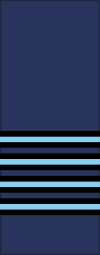 |
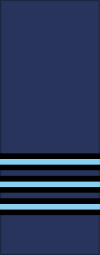 |
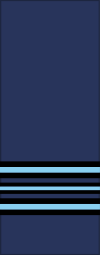 |
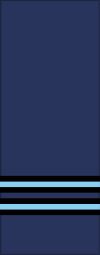 |
 |
 |
 | ||||||||||||||||||||||||
| Air Chief Marshal | Air Marshal | Air Vice-Marshal | Air Commodore | Group Captain | Wing Commander | Squadron Leader | Flight Lieutenant | Flying Officer | Pilot Officer | Officer cadet | ||||||||||||||||||||||||||
Airmen
| Equivalent NATO code | OR-9 | OR-8 | OR-7 | OR-6 | OR-5 | OR-4 | OR-3 | OR-2 | OR-1 | |||||||||||||||||||||||||||
|---|---|---|---|---|---|---|---|---|---|---|---|---|---|---|---|---|---|---|---|---|---|---|---|---|---|---|---|---|---|---|---|---|---|---|---|---|
(Edit) |
 |
 |
 |
 |
No equivalent | No equivalent |  |
No insignia | ||||||||||||||||||||||||||||
| Master Warrant Officer | Senior Warrant Officer | Warrant Officer | Sergeant | Corporal | Leading Aircraftman | Aircraftman 1 | Aircraftman 2 | |||||||||||||||||||||||||||||
Installations and bases
AircraftCurrent inventory.jpg) Bangladesh Air Force MIG-29UB fly over .jpg) A BAF AW139 Maritime search and rescue helicopter .jpg) BAF Lockheed C-130J Super Hercules
Missiles.jpg) Bangladesh Air Force FM-90 Crotale SAM
Future modernisation plansThe BAF has an ongoing modernisation programme under Forces Goal 2030 to become a strong force to defend the sky of Bangladesh. To efficiently perform the increasing duties and responsibilities, the air force is being divided into two separate commands: Southern air command and Northern air command. A new air base is being set up under southern command at Barishal to ensure maritime security. A maritime air support operation centre (MASOC) will be set up under southern command.[17] Another air base is under construction at Sylhet.[29] Bangladesh has signed a government to government contract with the United Kingdom for the supply of two off-the-shelf C-130J aircraft currently in service with the Royal Air Force.[30] In June 2019, another contract was signed for the procurement of additional three off-the-shelf C-130J aircraft from UK.[31] As of May 2020, two of the aircraft have been delivered.[15] On 20 June 2018, the Bangladesh Air Force signed a contract with China National Aero-Technology Import & Export Corporation (CATIC) for the procurement of seven K-8 jet training aircraft.[32][33] On 29 October 2019, Italian company Leonardo announced that it has secured a contract to supply Kronos Land 3D AESA radar systems to the Bangladesh Air Force to provide air surveillance and detect and track targets in tactical environments. However, the number of radars ordered were not disclosed.[34] In the third Bangladesh-UK strategic dialogue held in May 2019, two countries desired to further strengthen the defence ties between them. United Kingdom expressed its readiness to support Bangladesh with procurement of high calibre multi-role combat aircraft alongside other modernisation programmes.[35] In October 2019, US officials said Bangladesh had proposed to the United States to purchase advanced military equipment including multi-role combat fighters, attack helicopters and surface-to-air missile systems.[36] They offered Bangladesh Air Force two types of attack helicopters and BAF opted for the AH-64 Apache helicopters.[36] In January 2020, Boeing has confirmed that, the AH-64E attack helicopter has been down-selected by BAF after a competitive bidding process.[37] In January 2020, the minister responsible for defence affairs in the parliament, Mr. Anisul Huq told the parliament that process is going on to procure 16 multirole combat aircraft, eight attack helicopters, three VVIP helicopters, two air defence radar units, 24 primary trainer aircraft, two light aircraft, one K-8W simulator, four MRAP vehicles, one AW-119 simulator, 2 counter drone surveillance radar system and one mobile ATC tower and life extension and upgradation of Mig-29 aircraft.[18] See alsoReferences
External links | ||||||||||||||||||||||||||||||||||||||||||||||||||||||||||||||||||||||||||||||||||||||||||||||||||||||||||||||||||||||||||||||||||||||||||||||||||||||||||||||||||||||||||||||||||||||
